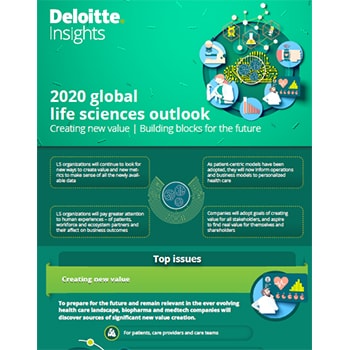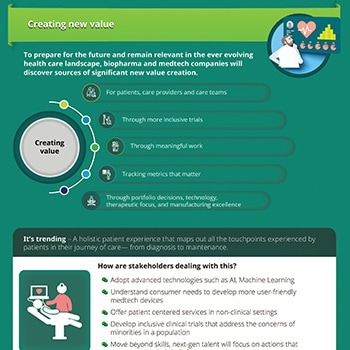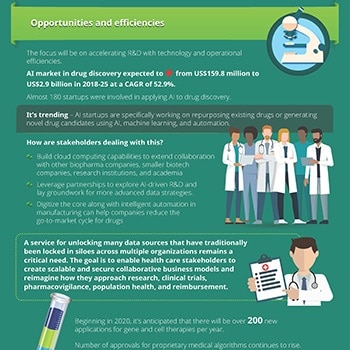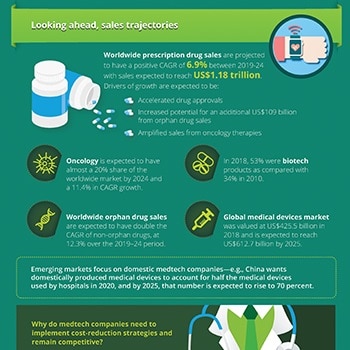Analysis
2020 US and global life sciences outlook
Creating new value: Building blocks for the future
Gene therapies, intelligent drug discovery and development, consumer wearables, telemedicine, and more—what are some of the drivers transforming the life sciences sector? How can biopharma and medtech organizations create new value in 2020, while tackling various challenges? What are the metrics that matter?
Explore content
- Download the report
- Infographic
- Creating new value
- Opportunities and efficiencies
- Building blocks for the future
A US perspective on life sciences trends
In 2020, we expect to see interoperability move significant steps forward. Personalized health data combined with artificial intelligence (AI) could fundamentally change not just the patient experience, but the human experience, too. And while the drive toward interoperability could improve efficiency in the years ahead, driving value and meaning for patients and consumers could pave the way forward for life sciences firms. Our 2020 global life sciences outlook takes an in-depth look into why life sciences companies should consider creating a holistic patient experience.
We are moving closer to the promise of true precision medicine and a future of health where we learn from every radically interoperable data point in the context of every patient. When we look back 20 years from now, 2020 may very well be seen as the year life sciences firms finally moved past their 20th-century models and stepped into a new era. Radical interoperability and evolving the patient experience are just two of the trends we see for 2020, here are three more:
- Organizations from outside of health care will continue to enter this space
- Clinical trials could become more inclusive
- Behavioral science could play a bigger role
Read the full blog to hear more about coming health trends from Deloitte’s US Life Sciences Leader, Mike DeLone.
Overview
The Life Sciences sector is at an inflection point. To prepare for the future and remain relevant in the ever-evolving business landscape, biopharma and medtech organizations will be looking for new ways to create value and new metrics to make sense of today’s wealth of data.
As data-driven technologies provide biopharma and medtech organizations with treasure troves of information, and automation takes over some mundane tasks, new talent models are emerging based on purpose and meaning. The integration of artificial intelligence (AI) and machine learning approaches within life sciences is making drug discovery and development more innovative, time-effective, and cost-effective.
The 2020 Deloitte Global Life Sciences Outlook takes a detailed look at the factors driving these changes and outlines suggestions on how biopharma and medtech organizations can aspire to find real value for themselves and their shareholders in the coming year. It also provides leaders with key questions and actions to consider in the year ahead.
Global life sciences sector issues in 2020
Creating new value
While advances in technology appear to drive more efficiency, biopharma and medtech leaders should look to more deeply understand ways to increase value and meaning for workers, patients, and ecosystem partners. Cultivating human strengths—for probing data, curating information, and asking the right questions— can help humans work with technology to think exponentially.
In order to be successful, leaders should look at how jobs can be redesigned around human-machine collaboration—that enhance workers’ capabilities and augment human abilities. Emerging technologies, meaningful work, and flexible work models could lure the next generation of talent that has the potential to create more value.
Key takeaways:
- In a future with interoperable and real-time data, the greatest returns will likely accrue to organizations that successfully mine data to deliver personalized solutions and meet consumer demands.
- Increased adoption of new technologies like telemedicine, virtual clinical trials, and AI could increase access to medical research and expand diversity.
- Large pharma companies will need to keep acquiring gene therapy companies, while smaller companies may take an increasing share of the market from big pharma by developing and commercializing products independently.
Opportunities and efficiencies
Medtech companies have the potential to drive efficiencies and tackle challenges by applying solutions such as IoT, machine learning, additive manufacturing, and augmented reality. A new breed of AI startups is leading the way on how new drugs are being developed.
Competition for AI talent will likely be fierce, and biopharma companies should not let traditional thinking and legacy cultures put them at a disadvantage. Emerging technologies could also positively drive change throughout each stage of the supply chain—leading to enhanced value to patients.
Key takeaways:
- The demand for small-volume, personalized medicines is driving operations away from large-scale bulk production to multiproduct facilities that require meticulous tracking.
- Large tech companies are new partners bringing computing power, manufacturing analytics, and advanced supply chain control towers to provide operations agility and better decision-making.
- Cloud computing could help leaders collaborate with other biopharma companies, smaller biotech companies, research laboratories, and academic institutions across the globe.
Building blocks for the future
The commercialization of gene and cell therapies comes at a time of wider drug price scrutiny from policymakers and the public. In 2020, drug pricing, health care expenditures, and market accessibility will likely continue to be the main concerns.
Patient-centered platforms and consumer health apps are now collecting more data, but there is confusion regarding which entity or individual owns that data. With a widespread access to valuable patient data, can organizations overcome the challenge of maintaining trust? In 2020, medtech companies will continue to face competition from consumer technology companies and new care models. Pharmaceutical firms’ environmental and social performance is also increasingly coming under scrutiny by stakeholders, including investors.
Key takeaways:
- More targeted patient engagement and the use of behavioral science could lead to better patient outcomes.
- Both biopharma and medtech could benefit from digital supply networks (DSNs) that produce greater product visibility, traceability, and inventory control in the supply chain.
- With the right protections in place for intellectual property (IP), medtech companies should be open to explore possible collaborations with technology companies, in turn developing more consumer-friendly devices.
Looking ahead, sales trajectories
Between 2019 and 2024, worldwide prescription drug sales are projected to have a positive CAGR of 6.9 percent with sales expected to reach US$1.18 trillion. However, uncertainty remains regarding drug pricing in the world’s largest market, the United States. Other challenges include risk due to patent expiration, increased clinical development spend for cardiovascular disease, decline in antirheumatics, and lower investments in R&D as a proportion of sales.
Tech giants are disrupting medtech and becoming a direct competitor. Also, downstream pricing pressures, stringent regulations, and operational inefficiencies due to industry consolidation are forcing many medtech companies to implement effective cost reduction strategies to remain competitive.
Key takeaways:
- Emerging market medtech companies are increasingly capturing a larger share of overseas markets, while cementing their presence domestically.
- Despite challenges, the life sciences industry is expected to continue investments in R&D to increase revenue generation from the biotech sector.
- Medtech companies can no longer rely on previous business models to drive growth and should adapt by considering new business models in addition to lowering costs.
Read more about 2020 life sciences and health care trends
2020 US and Global Health Care Outlook
2020 Life Sciences Regulatory Outlook
Explore our previous outlooks
Review or download previous life sciences sector outlooks.
2019 global life sciences sector outlook
2018 global life sciences sector outlook
2017 global life sciences sector outlook
2016 global life sciences sector outlook









Latest news from @DeloitteHealth
Sharing insights, events, research, and more